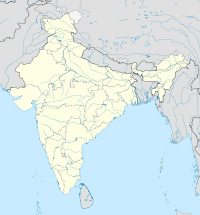- Dinjan Airfield
-
Dinjan Airfield Part of Tenth Air Force 
Type Military airfield Coordinates 27°32′16.86″N 095°16′10.01″E / 27.5380167°N 95.2694472°E Built 1943 In use 1943-1945 Controlled by United States Army Air Forces Dinjan Airfield was a World War II airfield, located approximately seven miles northeast of Chabua, in the state of Assam, India.
It was abandoned after the war and, though unused, is part of an Indian Air Force base.
Contents
History
Dinjan Airfield was built on an Assam tea plantation by the hands of thousands of plantation laborers, men, women and children in beginning in March 1942, as a result of the Japanese invasion of Burma in December 1941. When opened in the spring of 1942, its primary mission was the protection of cargo aircraft flying over "The Hump" (Himalayan Mountains) from nearby Chabua Airfield.
- 11th Bombardment Squadron (7th Bombardment Group), June - October 1942
- Initially equipped with a mixture of B-25 Mitchells and LB-30s (B-24A Liberators), the squadron flew missions against targets in Burma.
In October 1942, the Indian Air Task Force was activated at Dinjan to support Chinese resistance along the Salween River by hitting supply lines in Central and South Burma. The task force controlled operational activities of all Army Air Force units in India.
- 9th Photo Reconnaissance Squadron, March - July 1943; September 1943 - May 1944 (Detachment)
- 20th Tactical Reconnaissance Squadron, May - June 1944
- Assigned to Assam American Base Command (part of India Air Task Force). The mission of these units was photographic mapping in Burma. Flew F-4/F-5 (P-38) Lightnings.
- 51st Fighter Group, October 1942 - October 1943
- Equipped with Curtiss P-40 Warhawks and Lockheed P-38 Lightnings. The group defended the Indian terminus of the "Hump" airlift route over the Himalayan Mountains between India and China and airfields in that area. The group flew strafing, bombing, reconnaissance, and patrol missions in support of Allied ground troops during a Japanese offensive in northern Burma in 1943. Transferred from Dinjan to Kunming, China and was reassigned from the Tenth to Fourteenth Air Force.
- 311th Fighter Group, October 1943 - July 1944
- Using A-36 Apaches and P-51 Mustangs, the group supported Allied ground forces in northern Burma; covered bombers that attacked Rangoon, Insein, and other targets; bombed enemy airfields at Myitkyina and Bhamo; and conducted patrol and reconnaissance missions to help protect transport planes that flew the Hump route between India and China.
On 13 December 1943, 20 Japanese bombers, escorted by 25 fighters, hit Dinjan Airfield before US interceptors make contact, however, little damage was done and the US fighters caught the attackers shortly afterward. 12 of the 20 Japanese bombers and 5 fighters were shot down.
In the summer of 1944 with the lessening of the Japanese air threat, the base became a combat cargo airfield, supporting Allied ground forces fighting in Burma.
- 443d Troop Carrier Group, July- October 1944; May - August 1945
- Flew C-47s. The group's personnel and aircraft were assigned to the 1st Combat Cargo Group. Missions were concerned primarily with support for Allied forces that were driving southward through Burma but the 443rd also made many flights to China.
- 3d Combat Cargo Group, August 1944 - June 1945
- Flew C-47s. Supported ground forces during the battle for northern Burma and the subsequent Allied drive southward. Flew Allied troops and materiel to the front, transporting gasoline, oil, vehicles, engineering and signal equipment, and other items that the group either landed or dropped in Burma. Also evacuated wounded personnel to India. Reassigned to Myitkjina Airfield, Burma.
- 427th Night Fighter Squadron, May - June 1945
- Squadron headquarters only. P-61 Black Widow aircraft being flown out of forward bases in China.
With the end of combat in September 1945, Dinjan Airfield was abandoned. Today the runways of the former airfield can still be seen from aerial photography, however the base is overrun with vegetation and the land has returned to its natural state.
See also
References
 This article incorporates public domain material from websites or documents of the Air Force Historical Research Agency.
This article incorporates public domain material from websites or documents of the Air Force Historical Research Agency.- Maurer, Maurer (1983). Air Force Combat Units Of World War II. Maxwell AFB, Alabama: Office of Air Force History. ISBN 0-89201-092-4.
- www.pacificwrecks.com
External links
Airfields Burma India 
Units Groups Air Commando Bombardment Combat Cargo Fighter Reconnaissance Troop Carrier 443d Troop CarrierSquadrons 24th Combat Mapping · 426th Night Fighter Squadron · 427th Night Fighter SquadronUnited States Army Air Forces
First · Second · Third · Fourth · Fifth · Sixth · Seventh · Eighth · Ninth · Tenth · Eleventh · Twelfth · Thirteenth · Fourteenth · Fifteenth · TwentiethCategories:- Airfields of the United States Army Air Forces in the British Raj
- Abandoned airfields in India
Wikimedia Foundation. 2010.


